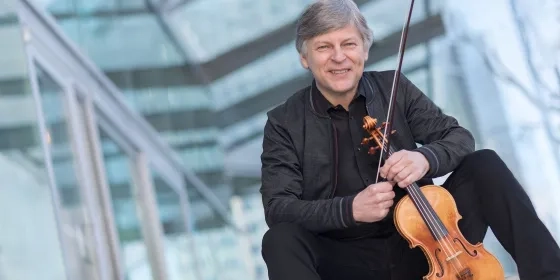Rare Violin Connects generations of students across the Country
The classical music world is small, intimate even. Over a musician’s lifetime, it’s typical to bump into old colleagues or friends from school or summer festivals or professional engagements in different ensembles, concerts, and even airport lines.
But bumping into the same rare violin after 30 years apart on the other side of the country? Now that’s the six-figure needle in the haystack. Nevertheless, that’s exactly what happened when Amy Beth Horman, who teaches violin in SFCM’s Pre-College division, took her 9-year-old daughter, Ava, to a lesson with Simon James, a member of the Seattle Symphony who instructs both conservatory and Pre-College students at SFCM.
“Simon and I were standing in an elevator talking about mutual connections, and I asked if he knew Jody Gatwood, my old violin teacher,” Horman said, recalling the exchange. “And Simon said, ‘I have his violin. That’s the instrument that you’ve been listening to.’ We both got out of the elevator and almost shook it off. But I stopped and said ‘This is so weird! Do you think this is as unusual as I do?’”
James began teaching at SFCM this semester and instructing Horman’s daughter, Ava. It turns out that James had been demonstrating techniques and solos with the very same violin that Amy Beth grew up listening to when she was the age her daughter Ava is now. “The player matters of course, but it’s the same voice,” Horman said. “It’s a very special instrument. It’s amazing that Ava and I are hearing the same voice.” The special if not distinctive instrument was made by Jean Baptiste Vuillaume in 1827. Its sound is big and broad and warm, with a deep bass and a bright, clear high register. It’s also a bit larger than typical violins.
“It’s got enough power to carry over an orchestra,” James said. “Every time I play it someplace someone asks me, ‘how long have you had your Strad?’” The Vuillaume was designed after a Grand Pattern Stradivarius, and is valued at several hundred thousand dollars.
Horman was upset when her teacher sold the Vuillaume. “That violin raised me,” she recalled, explaining that she began studying with Gatwood in Washington D.C. in 1984 . “I really looked up to what he was able to do with it.” She said that he sold the violin in ’89, and that when he told her she felt crushed. She said that he told her later he regretted giving up the instrument, but Gatwood was buying a house at the time, and the instrument could be tempermental in the humidity of the D.C. area. “Later in my career, the only violins that were in the same league as the Vuillaume were the Strads I played,” Gatwood said.
But James didn’t purchase the violin directly from Horman’s old teacher. There was an owner in between: Peter Kaman of the Seattle Symphony...James’ colleague in the first violin section there. Discovering that Horman’s childhood violin teacher played the same instrument as him, her daughter’s current teacher, was “well, pretty weird,” said James. “It was an extraordinary moment.”
Ava Pakiam, Horman’s daughter, was admitted to the Pre-College program at the San Francisco Conservatory Music early at the age of 7 and currently plays on a 3/4 size Gagliano selected for her by Potters Violin Shop in Maryland. “People have asked me over the years if Ava is following in my footsteps, but she’s farther along than I was at her age,” Horman said. “Walking out of the Conservatory when we figured the connection out, Ava said, ‘I love this, it’s like it connects all of us now. There’s this bond now, knowing that that violin is there.’ She’s right. It is the tie that binds us. It’s a beautiful, wonderful thing.”
